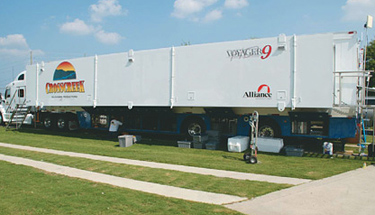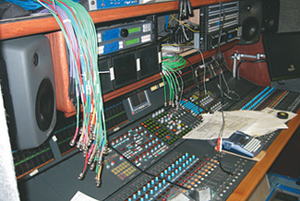Now, Voyager 9
ALABASTER, ALA.
In response to the increased demand for HD broadcasts of sporting and entertainment events, Crosscreek Television Productions has added a second HD/surround sound expandable mobile product truck to its fleet.
And to meet the higher demands of surround sound productions, Crosscreek came up with some creative solutions to squeeze more technical capabilities in less space, while at the same time, increasing the square footage of the audio control room to provide a better acoustic and operating environment for the audio engineer/mixer.
MORE AUDIO ROOM
The new Voyager 9 is a 53-foot trailer with a 50-foot by 5-foot street side expansion section and was designed by Crosscreek and built by systems integrator Beck Associates. As a sister truck to Crosscreek's Voyager 8, Voyager 9 originally started as its clone and then grew into something else.
"We added 3G for video, and for audio we added a MADI interface to the router and additional AES," said Butch Mueller, director of engineering for Crosscreek Television Productions. "It's grown by 20 percent of the Voyager 8 truck."
Mueller felt that the audio room in Voyager 8 was a little small, "so for Voyager 9 we added 8-10 inches of depth to the audio room to make it more comfortable. It's not as big as it needs to be, but it's as big as we could afford it to be, juggling weight, space, performance and cost."

The new Voyager 9 is a 53-foot trailer with a 50-foot by 5-foot street side expansion section. The audio control room is at one end of the truck, behind the video production room. Other sections of the truck include video operations, transmission and tape.
The Voyager 9 audio control room, measuring about 8x8 feet, houses a Calrec 64-fader Sigma audio console with Bluefin high density signal processing. The audio console system includes 192 channels of digital inputs and outputs (I/O), 128 channels of MADI, and 128 analog input channels—96 with mic preamps and 32 line level—and 96 analog outputs. The system can be configured for up to 52 full 5.1 surround channels.
"5.1 surround is used for most of the racing and entertainment packages," Mueller said. "The truck is set up for monitoring surround with Genelec speakers in the audio room and also the production control room."
The audio console control surface is positioned across the width of the truck. Every bit of space counts, so Calrec worked closely with Crosscreek to redesign the console surface to custom-mount it on a tabletop. This provided 15 more rack units of space underneath the console than would have been possible otherwise.
The five under-console racks house the Sigma analog and digital electronics and power supplies, analog I/O for the Pesa Cheetah DRS audio routing switcher, Harris/Leitch analog stereo audio distribution amplifiers, RTS Adam intercom breakout panels, power strips and the sub-woofer.
In the overhead bridge of racks above the audio console are installed gear like 360 Systems Digicart Es and Instant Replay, a CD player, Aphex and DBX processors, hot mic and cue amplifiers, JK Audio digital hybrids and couplers, and Circle Surround and Dolby Digital surround encoders. Mueller said that Circle Surround is used for ESPN broadcasts.
Also located there are the RTS intercom source assignment panel, two-to-four wire converters, telephone interfaces, as well as utility amplifiers, power supplies for the two-wire intercom, and RTS Adam intercom stations.
"These are the things that are commonly used and are placed within easy reach of the audio person," Mueller said.
The truck has wiring for additional outboard gear like effects or dynamics, should they be needed. Mueller said that based on experience with Voyager 8 which also has a Calrec Sigma, "the audio operators tend to use the compression and dynamics on the Calrec almost exclusively, so we pulled out most of the compressor/limiters, which was a space and weight savings."
Below the overhead racks is another series of racks with flat-panel video monitoring, Motorola two-way radios, and the front Genelec loudspeakers.
Behind the audio operator are three 49RU racks mainly for digital and analog audio patching. Also installed there are Harris/Leitch AES DAs and more analog stereo audio DAs, a Wohler monitor, metering panels, AES, MADI, and control interfaces to the Pesa Cheetah DRS audio router, Calrec breakout panels, and the rear Genelec loudspeakers.
ROUTING AUDIO
Most of the equipment in these racks is installed on recessed rails, to allow room for the expando side to retract into the truck.
The exterior connector panels are situated just behind the tall racks, on the other side of the truck wall. "We wanted the I/O panels as close as possible to the room so we didn't have to run cable through the length of the truck, and add unnecessary weight," Mueller said.

This Calrec audio console was installed in the Voyager 9 audio control room. Back inside the audio room, the 1024-square Cheetah DRS router handles both digital and analog audio feeds. Audio sources within the truck, like those from the Sony VTRs or EVS playout servers, are first run through distribution amplifiers which then feed the router and the Calrec console.
Part of the audio routing system is used to select sources for all Wohler monitors on the truck.
The ability to saving settings on the Calrec console and Pesa router is an immense time saving when preparing broadcasts like NHRA drag racing that are done over and over again. "You can store a show and recall it back which saves time in patching," Mueller said.
Audio within the truck is discrete, and is embedded only for transmission. The truck includes four Evertz embedder/de-embedders for transmission and eight utility. While designed as a standalone unit, Voyager 9 may also be called to work in a multiple truck environment.
Crosscreek takes advantage of the Pesa DRS (distributed router systems) for east connection between its own B and C units, or other locations. With the DRS system, analog line level or AES audio I/O interfaces connec to the Pesa router via CAT-5 cable, allowing each truck to access each others' signals.
"It's a cool system," Mueller said. "We can go up to four trucks if we need to. Each I/O has 128 inputs or outputs in 1RU frame." If each truck also has a Pesa DRS system, these too can be tied together to act as one larger router.
MADI interfaces for both the Pesa routing system and the Calrec console also enhance truck-to-truck interconnectivity by providing a means for sharing signals among consoles, routing switchers or digital audio workstations from dissimilar manufacturers. MADI, the AES-10 standard for a serial multichannel audio digital interface, allows 64 digital audio channels of 24-bit and 48 kHz to be multiplexed on a single coaxial cable or over fiber.
Voyager 9 includes an Adam matrix intercom system with keypanel user stations throughout the truck. The intercom system also includes interfaces for two-way radio, two-wire systems, telephone, and GPI/O, as well as an RVON card for tying other truck's intercom systems together.
The Calrec audio console system provides 16 GPI/O to the central Image Video tally system, which is also integrated to the 16 cameras, routing switcher, Grass Valley Kayenne video switcher, and monitors.
"There are a variety of ways this can be used, depending on how the system is set up," Mueller said. "For example, switching something on the Kayenne could be used to trigger audio events."
Voyager 9 rolled down the road last month with a heavy schedule of Southeastern Conference sports ahead.
The professional video industry's #1 source for news, trends and product and tech information. Sign up below.
